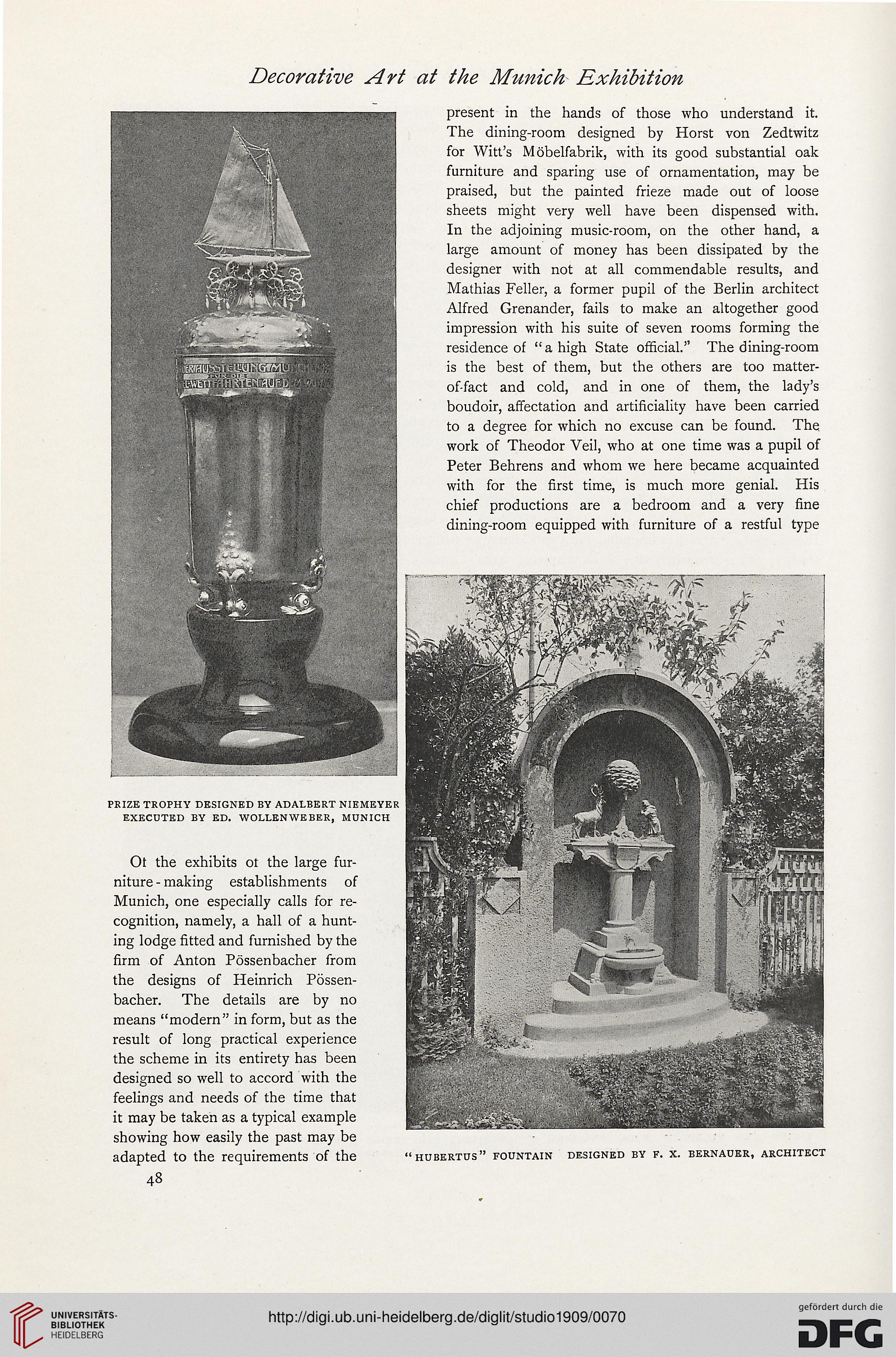Decorative Art at the Munich Exhibition
PRIZE TROPHY DESIGNED BY ADALBERT NIEMEYER
EXECUTED BY ED. WOLLENWEBER, MUNICH
Ot the exhibits ot the large fur-
niture - making establishments of
Munich, one especially calls for re-
cognition, namely, a hall of a hunt-
ing lodge fitted and furnished by the
firm of Anton Pössenbacher from
the designs of Heinrich Pössen-
bacher. The details are by no
means “modern” in form, but as the
result of long practical experience
the scheme in its entirety has been
designed so well to accord with the
feelings and needs of the time that
it may be taken as a typical example
showing how easily the past may be
adapted to the requirements of the “hubertus” fountain designed by f. x. bernauer, architect
48
present in the hands of those who understand it.
The dining-room designed by Horst von Zedtwitz
for Witt’s Möbelfabrik, with its good substantial oak
furniture and sparing use of ornamentation, may be
praised, but the painted frieze made out of loose
sheets might very well have been dispensed with.
In the adjoining music-room, on the other hand, a
large amount of money has been dissipated by the
designer with not at all commendable results, and
Mathias Feller, a former pupil of the Berlin architect
Alfred Grenander, fails to make an altogether good
impression with his suite of seven rooms forming the
residence of “a high State official.’’ The dining-room
is the best of them, but the others are too matter-
of-fact and cold, and in one of them, the lady’s
boudoir, affectation and artificiality have been carried
to a degree for which no excuse can be found. The
work of Theodor Veil, who at one time was a pupil of
Peter Behrens and whom we here became acquainted
with for the first time, is much more genial. His
chief productions are a bedroom and a very fine
dining-room equipped with furniture of a restful type
PRIZE TROPHY DESIGNED BY ADALBERT NIEMEYER
EXECUTED BY ED. WOLLENWEBER, MUNICH
Ot the exhibits ot the large fur-
niture - making establishments of
Munich, one especially calls for re-
cognition, namely, a hall of a hunt-
ing lodge fitted and furnished by the
firm of Anton Pössenbacher from
the designs of Heinrich Pössen-
bacher. The details are by no
means “modern” in form, but as the
result of long practical experience
the scheme in its entirety has been
designed so well to accord with the
feelings and needs of the time that
it may be taken as a typical example
showing how easily the past may be
adapted to the requirements of the “hubertus” fountain designed by f. x. bernauer, architect
48
present in the hands of those who understand it.
The dining-room designed by Horst von Zedtwitz
for Witt’s Möbelfabrik, with its good substantial oak
furniture and sparing use of ornamentation, may be
praised, but the painted frieze made out of loose
sheets might very well have been dispensed with.
In the adjoining music-room, on the other hand, a
large amount of money has been dissipated by the
designer with not at all commendable results, and
Mathias Feller, a former pupil of the Berlin architect
Alfred Grenander, fails to make an altogether good
impression with his suite of seven rooms forming the
residence of “a high State official.’’ The dining-room
is the best of them, but the others are too matter-
of-fact and cold, and in one of them, the lady’s
boudoir, affectation and artificiality have been carried
to a degree for which no excuse can be found. The
work of Theodor Veil, who at one time was a pupil of
Peter Behrens and whom we here became acquainted
with for the first time, is much more genial. His
chief productions are a bedroom and a very fine
dining-room equipped with furniture of a restful type




